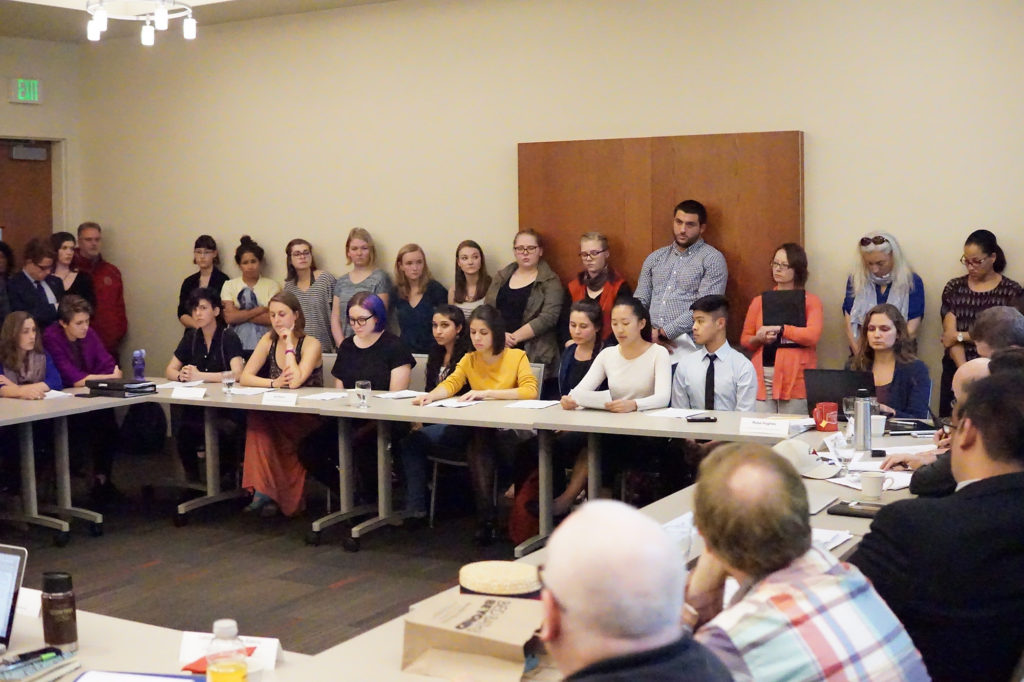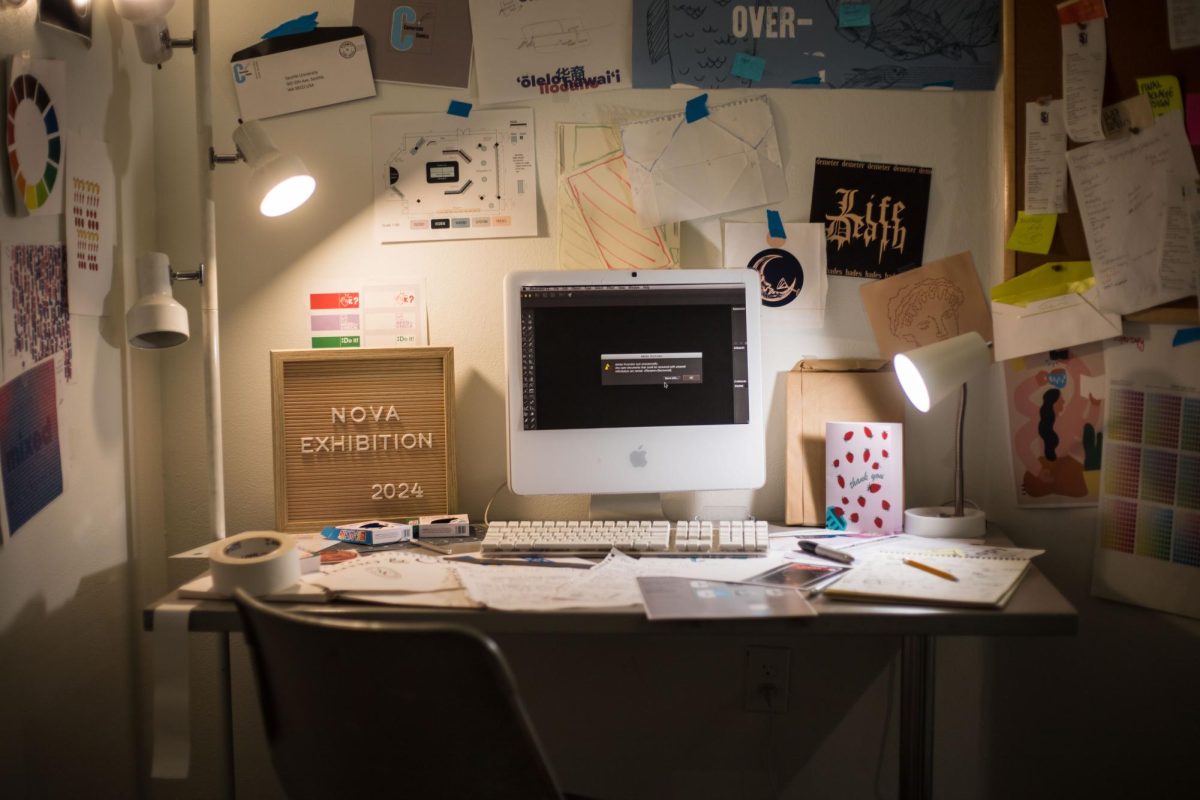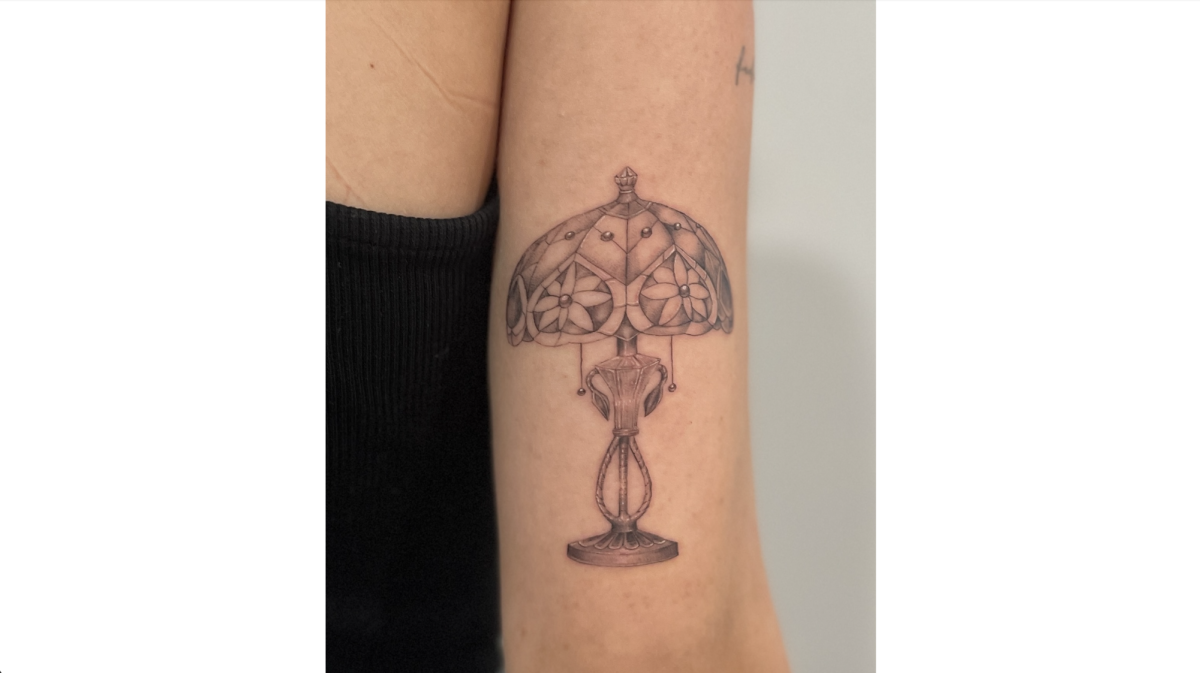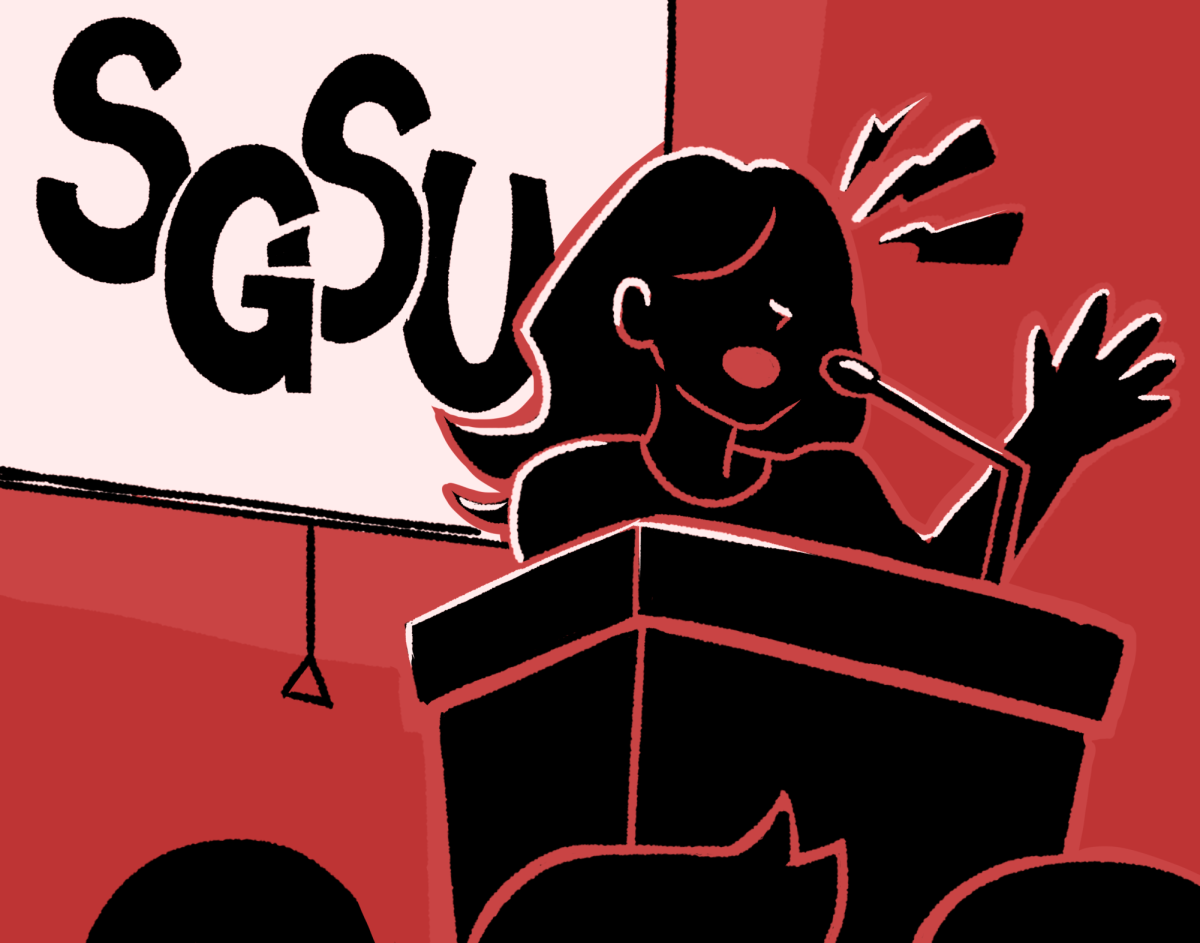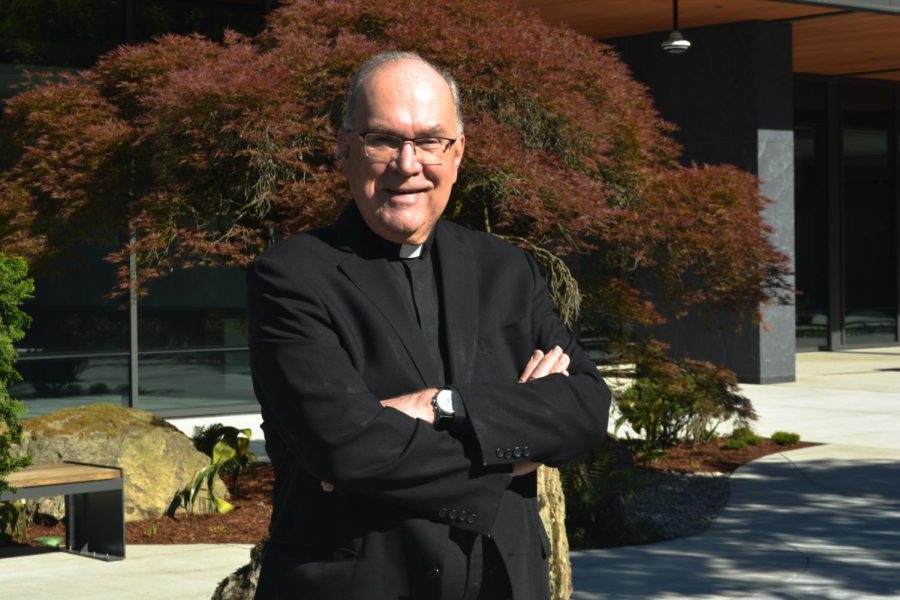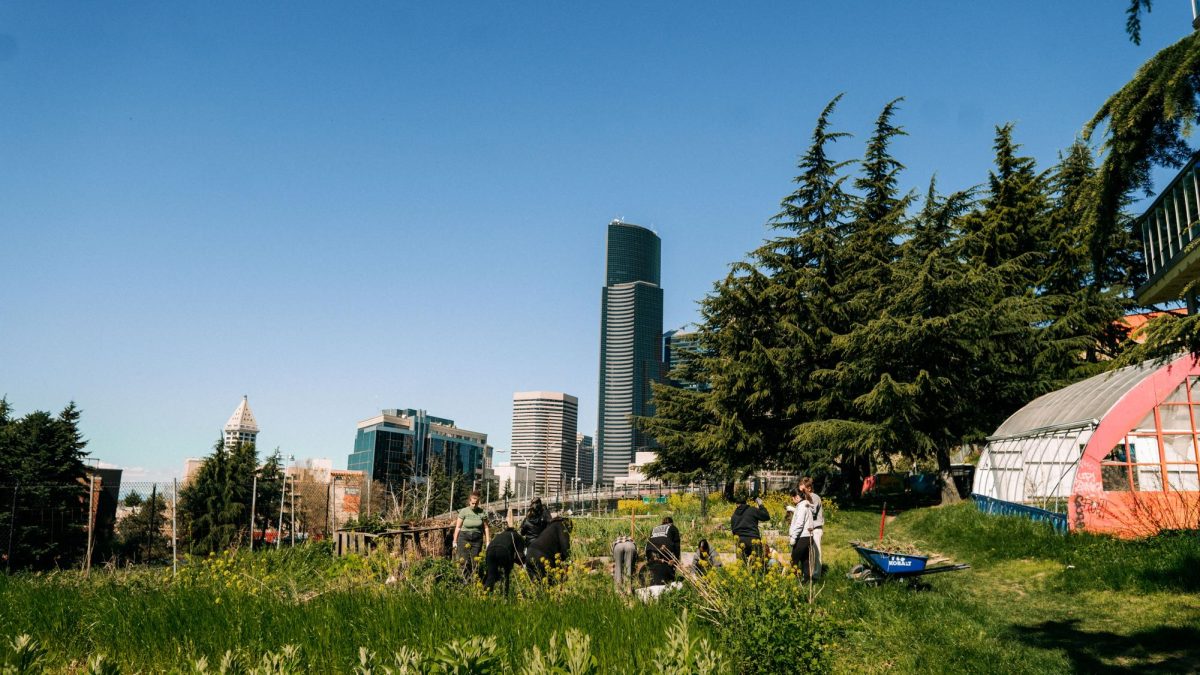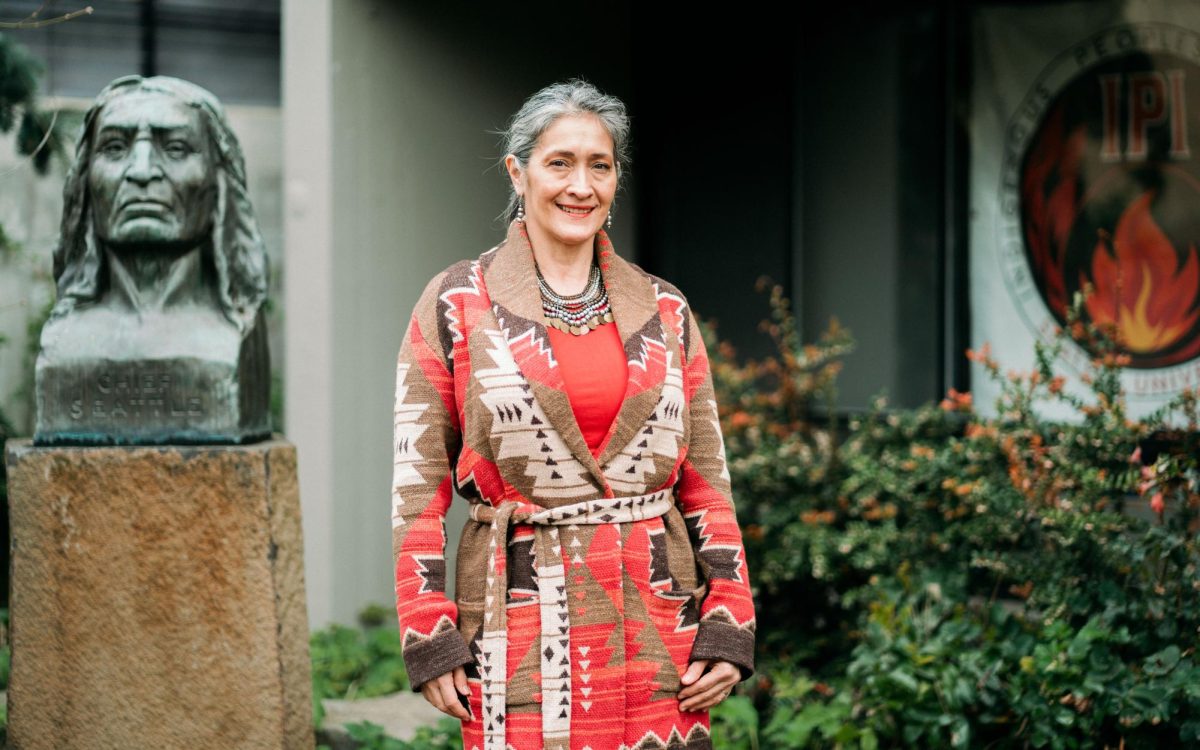One year ago this week, a group of students marched into the Casey building and occupied the Matteo Ricci College (MRC) office for 24 days, former Dean Jodi Kelly began what would be her final weeks in the position and Seattle University faced one of its most heavily publicized protests in the school’s history.
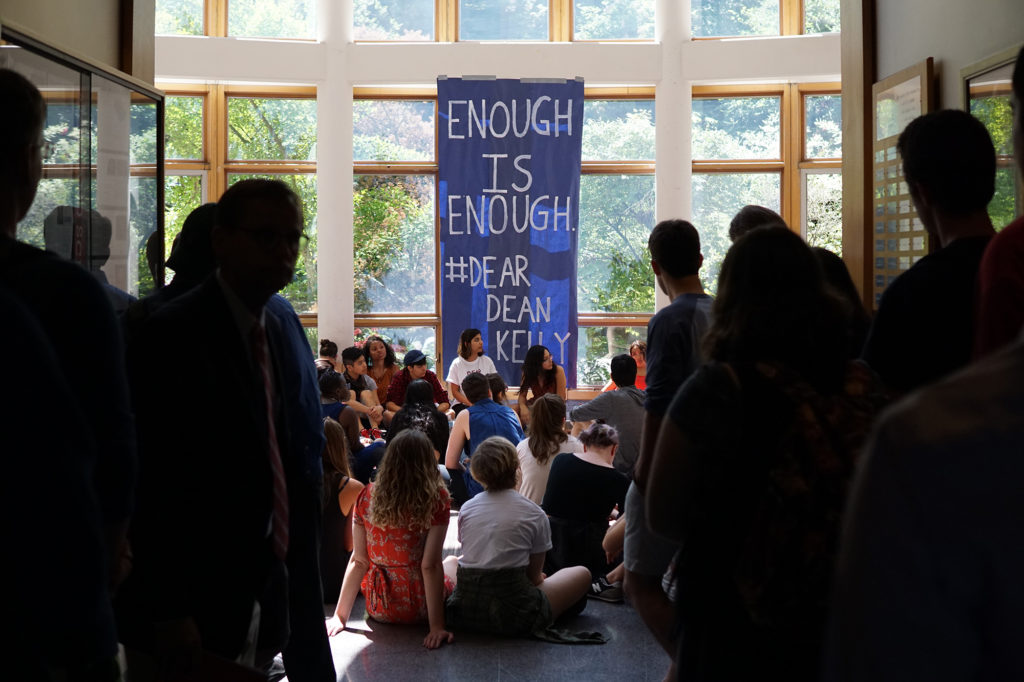
Onlookers packed into Casey Building to listen to members of the MRC Coalition talk last year.
MRC has been described in many different ways over the 40 years of its existence, such as small, humanities- centric and academically rigorous. More recently, it’s been labeled with a slew of less flattering adjectives including, but not limited to: racist, sexist and Eurocentric.
While the college is seemingly in a state of flux following the sit-in, a descriptor that’s remained constant throughout the last four decades is its “experimental” nature. And right now, many stakeholders say that the small, experimental college is in a prime position to address and change the systemic and explicit issues brought to the surface last spring.
“It’s experimental in the sense that they’ve done various things over these last 40 years to reinvent themselves,” said Interim Dean of MRC Paulette Kidder. “And I think Matteo Ricci is ready for a new reinvention of itself.”
Following the sit-in, a lot has changed:
The whole university was asked to make budget cuts across the board for the upcoming fiscal year, and MRC was asked to cut 9.7 percent.
Paulette Kidder was appointed Interim Dean, and has agreed to fulfill the position through the 2017-18 school year.
The college began hosting quarterly anti-bias and anti-racism events. In addition, MRC faculty have been encouraged to attend anti-racism training. Kidder even made funds available for faculty members to attend trainings over the summer or next academic year.
The college is currently undergoing an external program review—a common practice in colleges across the country meant to ensure that all concerns are benig voiced, heard and addressed. This is the college’s first official program review ever.
The college created a shared- governance body called the Student Advisory Committee. Most other schools and colleges on campus already have some version of this.
Last summer, Interim Provost Bob Dullea created a task force that would evaluate the culture, curriculum and climate of MRC. Its members have been working for the last several months to address the problems and pose solutions.
On March 31, the task force gave its official recommendations to the provost.
The recommendations included key factors of MRC’s institutional identity including supporting an ongoing and genuine commitment to diversity, inclusivity, anti-racism, and anti-oppression, establishing a system of faculty tenure and establishing systems of shared governance for students and faculty.
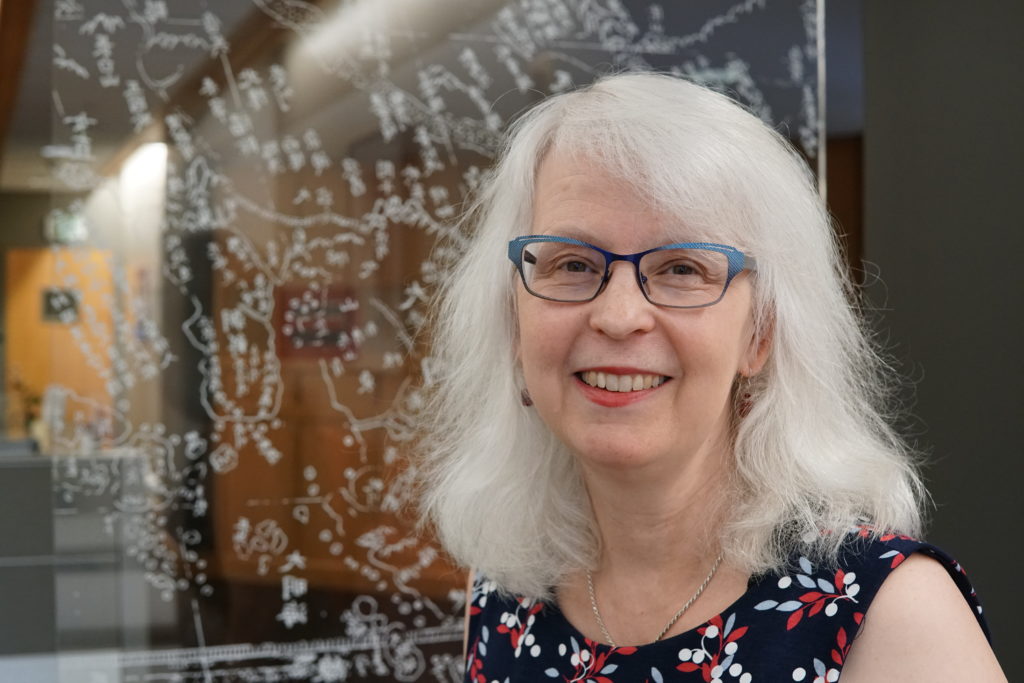
Paulette Kidder, interim dean of the Matteo Ricci College, standing in the office on the first floor of the Casey Building.
Administrative Lessons Learned
Dullea says a personal lesson he takes away from the sit-in is the importance of maintaining conversations and connections across the various stakeholders in an organization.
“I think you always have to be trying to connect across the organization with people that you wouldn’t normally bump into,” Dullea said, adding that, in his opinion, the sit- in identified a gap between students and administration.
“Almost definitionally, it highlighted the gap,” Dullea said.
He said that, initially, he was surprised when the sit-in occurred.
“In hindsight and with a better understanding of the issues, I have a better understanding of why it happened,” Dullea said.
Looking back, Dullea said he doesn’t think there’s a lot the administration should have done differently once the sit-in began. Alternatively, he said, there are things that could have been done differently in the college prior to the sit-in that would have prevented the need for a sit-in altogether.
“I just think making sure that all the schools and colleges have effective policies and practices for good management and governance is really important,” Dullea said. “I think providing different ways for students and faculty to discuss any concerns or questions they might have is also important.”
Seattle University President Fr. Stephen Sundborg, S.J., says the university took away three major lessons from the sit-in.
First, it discovered the need for mechanisms or structures in place enabling students and faculty voices to be heard.
The second lesson, Sundborg says, is issues of intersectionality being brought to the forefront of campus conversations.
And finally, Sundborg says a lesson is that the university as a whole, not limited to MRC, needs to review its curriculum and the ways in which it can be more “inclusive of the variety of the diversity of the students that we have.”
Sundborg says he thinks Seattle U is healthier following the sit-in.
“It was not an easy experience, it was an experience of great debate and conflict and not easy at all,” Sundborg said. “But I think we’re a healthier university and that we’re more aware. We’re building better structures, we’re looking more at our curriculum, we’re facing more of our biases.”
Sundborg says he was partially surprised that the sit-in occurred.
“Yes, yes I was surprised,” he said, pausing for a moment and revising his answer. “Well was I surprised or was I not? I was somewhat surprised.”
He said he was aware of student concerns about MRC, as well as some of the measures taken to look at the college, adding that he knew of problems that had been developing in the college for about two months prior to the sit-in.
“So I knew that there was an issue in regard to the college, so I didn’t know what shape it would take in regard to how it would come forward,” Sundborg said. “So I wasn’t surprised in terms of, that there were the developments and concerns of the students about the college, but I was surprised I think as anyone in the university would have been about, well what shape does it take.”
Sundborg added that he took away personal lessons from the sit-in, and events that happened around that same time.
“I discovered in myself some racial bias and I was really glad that I had been able to discover it because I wasn’t aware of it,” Sundborg said. “I had some examples last year where I realized that I had a bias, categorizing people and stereotyping people, and it’s good to learn those. You don’t easily change biases, but you can’t change them unless you become aware of them.”
He said these biases are a result of all sorts of cultural factors. In addition, he said he learned far more about the concept of intersectionality, a term which he said he had not fully understood prior to the sit-in.
“America is racist, and deeply within our culture, and all of us are,” Sundborg said. “So the MRC was not a learning around bias, it was the issue around becoming more highly aware of the issues of identity.”
For now, the provost will continue to look over the task force recommendations and said he should present his official response shortly.
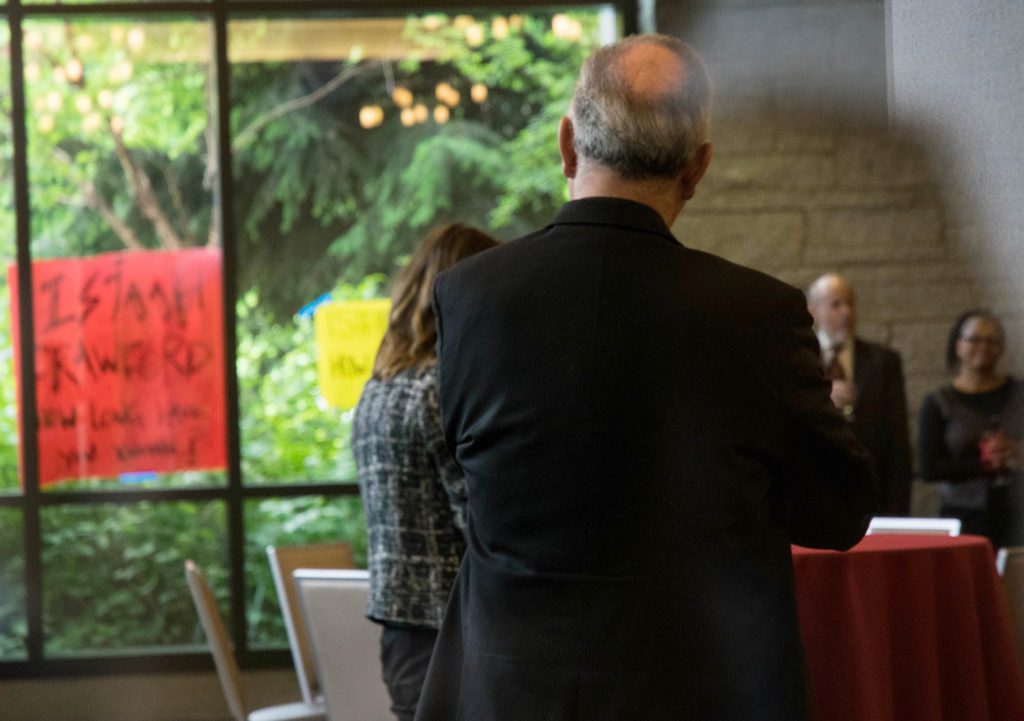
President Father Steven Sundborg, S.J. looked on as the MRC Student Coalition put up their posters during Provost Isiaah Crawford’s farewell party.
Curriculum Reform
Currently, there are three majors within MRC: Humanities, Humanities for Leadership and Humanities for Teaching. The task force recommends the majors converge into one single tract called Humanities for Peace and Justice, which is intended to be a “transformative humanities- focused Bachelor of Arts degree that focuses on the transdisciplinary study of justice,” according to the task force report.
Unlike the majority of the Seattle U students, those in MRC take their own core. Because of the nature of the curriculum design, core classes and major requirements in MRC are deeply intertwined. Some have said the relationship between the two feels less segmented than that between the university core and major requirements.
The task force recommended what can be interpreted as a hefty overhaul of the current curriculum. The proposed courses are deeply social justice oriented, bringing the humanities into the 21st century.
Emily Lieb is an MRC faculty member and the co-chair of the Matteo Ricci College Task Force. Lieb emphasized that the task force is not seeking to completely restart the Matteo Ricci College. Rather, they are trying to build upon the uniqueness and strength of the pre-existing institution.
Changing university curriculum takes a long time, and the task force’s curricular recommendations, once approved by university leadership, still need to go through several other shared-governance bodies for approval, such as Academic Assembly.
As of now, MRC has had one series of required history courses approved to be changed for next year’s students. Typically, MRC students take a series of three sequential history courses during each quarter of their freshman or sophomore year. Starting next year, they will have the opportunity to enroll in the revamped history series if they haven’t taken it yet.
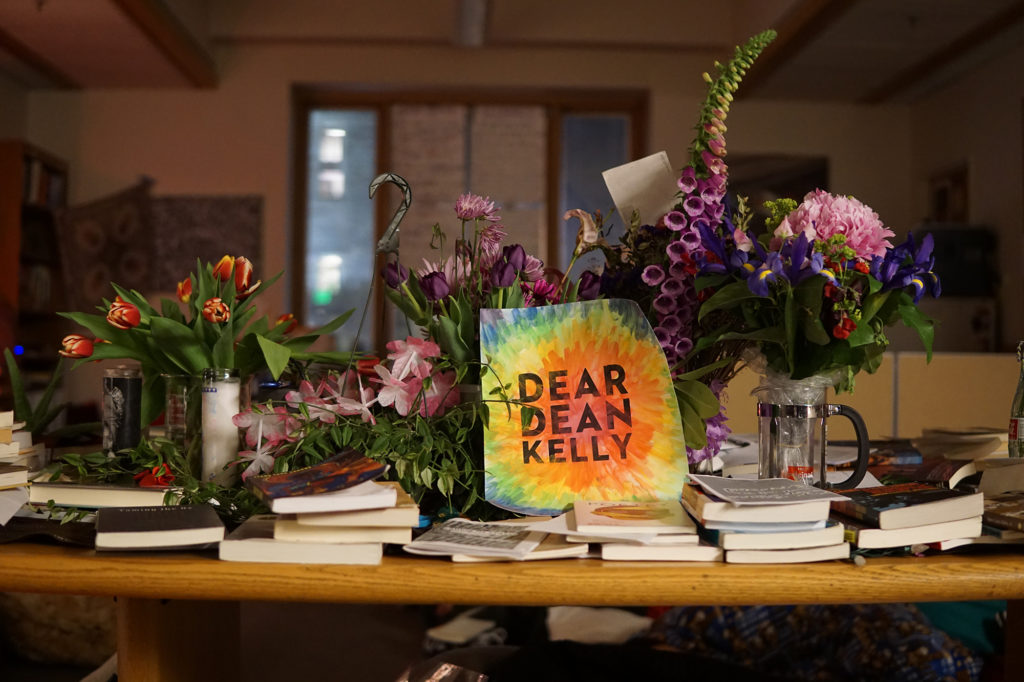
Students taking part in the sit-in brought books from their personal libraries that highlighted the experiences of marginalized voices.
Potential Move to Arts & Sciences
One of the most notable recommendations is the prospect for the college’s future housing in the university. There have been three options set forth.
The first option is for MRC to stay as it is and continue to work on its culture, curriculum and climate the same way it’s already been doing.
The second option is for the college to become a department within the College of Arts & Sciences
The third option is for the college do move into Arts & Sciences, followed by Arts & Sciences dividing into two colleges: the College of Arts and Humanities, and the College of the Social Sciences.
Lieb said she thinks MRC should move into the College of Arts & Sciences, but the task force intentionally didn’t name their preference because ultimately, that decision should fall on the shoulders of university leadership.
Audrey Hudgins, professor in MRC, said she is unsure about the college’s continued existence.
“I could really go either way,” she said. “There’s a lot of neat stuff that’s happening over here [in MRC], but there’s a lot of neat stuff that’s happening everywhere. And so if we have this core aspect of our character that we could maintain in a different form, what does it really matter what it looks like?”
Hudgins added that, out of the three options, she prefers the third. She said moving MRC into the College of Arts & Sciences wouldn’t necessarily represent a loss, but could allow for the same sort of culture to continue.
“Arts & Sciences isn’t going to force a culture down our throat,” Hudgins said. “There would be some merging of those two cultures for sure, but you already know there’s a whole bunch of students in this college that would not want that culture to continue, because that’s the reason they did the sit-in in the first place.”
In the case that MRC does dissolve into a department, there are a number of logistical concerns to be addressed, including its name. Departments on campus aren’t typically named after Jesuits, so it’s unclear whether MRC would still bear the name of the Italian priest.
The Coalition pointed out that MRC’s curriculum has a tendency to focus strictly on the teachings of “dead, white men.” The college’s namesake fits into all three of those categories.
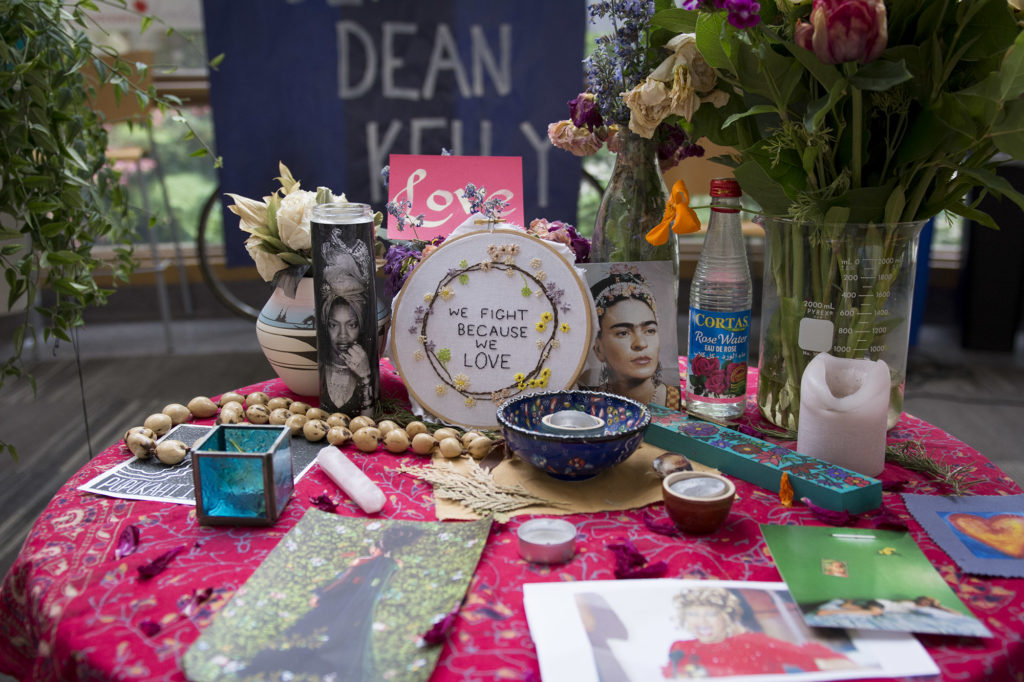
The altars in the Matteo Ricci office were filled with powerful women from all different races, and inspirational and supportive quotes.
Lieb said she would like the name to remain because, should it be changed, it could lead to a sort of erasure of the college in two major ways.
First, if you Google “Matteo Ricci College sit-in” today, you’ll be bombarded with stories from The Seattle Times, The Stranger, Capitol Hill Times, the Seattle Globalist and, of course, the Spectator. Should the name be changed, Lieb said, it may erase the historical aspects of the college and make it difficult to connect the dots between the sit-in and the new potential program.
Second, Lieb said, the name change could detract from the importance of MRC alums, because they would then have a degree from a program that no longer exists.
On Monday, during the Academic Assembly’s meeting, faculty and staff across various departments in the university discussed the recommendations for about 40 minutes. Of the faculty who spoke, they appeared to be in favor of the college moving into Arts & Sciences
An MRC student involved heavily in the college, who asked to remain unnamed, said they think shifting MRC into the College of Arts & Sciences does not get to the root of the issues identified during the sit- in, namely institutionalized racism and sexism.
“My thought is that, if you push it into Arts & Sciences, nothing is gonna happen,” the student said. “You’re not addressing any issue, you’re getting rid of what you think is the issue because you’re afraid of what might happen…you’re not gonna change anything and you’re not gonna change institutionalized racism, you’re not gonna change racist and micro- aggressed thoughts if you just get rid of it. That’s not how you deal with issues like this. You have to call it out and learn from the issue, you don’t just dissolve it. And that’s why I don’t understand the reason behind the task force recommending that.”
Low enrollment continues to be a problem for Matteo Ricci College, and the president and provost both said it’s a concern for them, and is something that will need to be addressed in the university’s strategic five-year plan. The task force also recommended a market analysis of the new degree to determine how to effectively market it to prospective students.
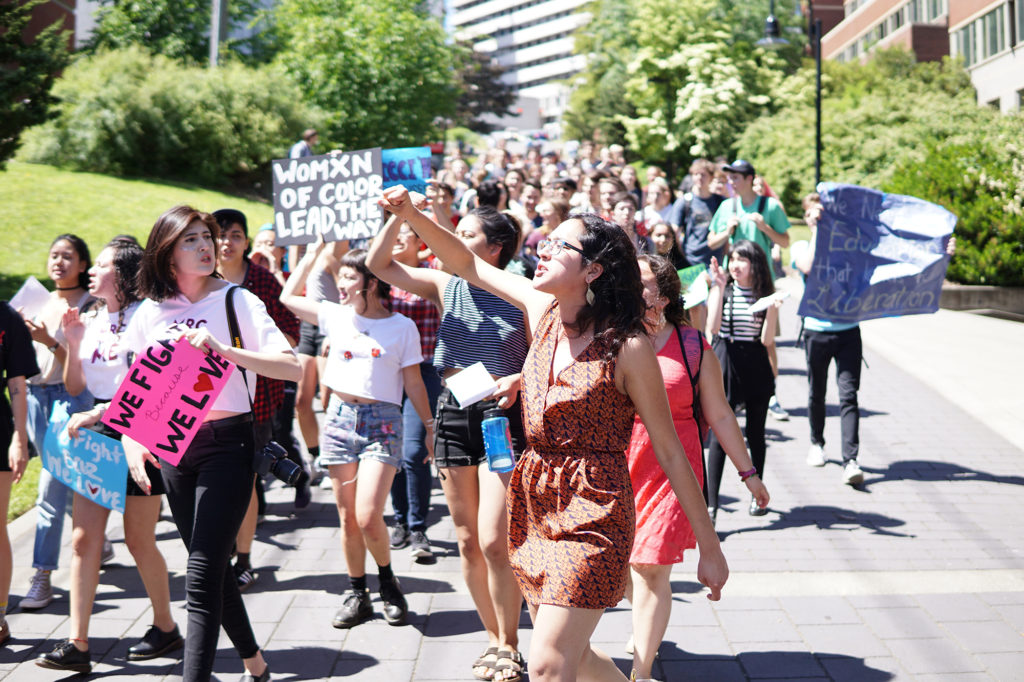
Coalition members and their supporters marched through the campus on Thursday, May 12, 2016.
Tenure Track
Unlike every single college at Seattle U, Matteo Ricci does not have a tenure track. In fact, even associate deans have been barred from tenure. Despite the absence of tenure, some MRC faculty who teach through other departments have managed to get tenure or on the tenure track through their respective departments.
The task force recommended the creation of a tenure track, and suggests three current full-time MRC faculty be converted to tenure-track, and at least one tenure position for new faculty be created.
MRC took one of the biggest budget cut hits in the recent string of reductions. Dan Washburn. the Associate Dean of the Matteo Ricci College, said he doesn’t expect any layoffs of contracted employees.
It’s also worth noting that two full- time MRC professors will retire by the end of the year, which may have contributed to the college’s ability to retain its current full-time employees.
Despite the large cut, the college plans to hire a full-time faculty for a three-year contract for next year.
Washburn said the current lack of a tenure track is concern for the college’s ability to attract and retain talented faculty.
“It’s an obstacle, yeah. I am hopeful that a three-year contract will be attractive to quality applicants. But part of it is that I want to treat the faculty well once they’re here in a way that serves the students,” Washburn said.
Washburn said the college is waiting on the program reviewer’s assessment before they proceed with big decisions.
“MRC is in a curious moment right now, and we are questioning big picture issues,” Washburn said. “Her insights need to be received before we can make those determinations.”
Tess can be reached at
[email protected]







